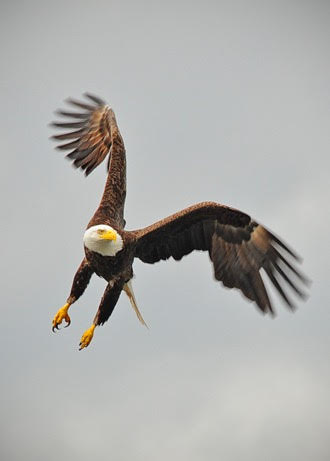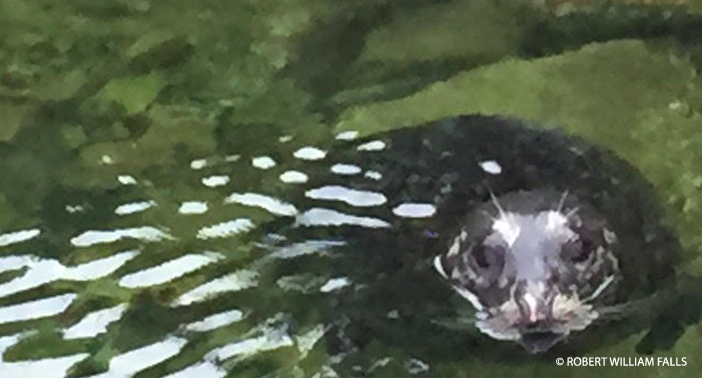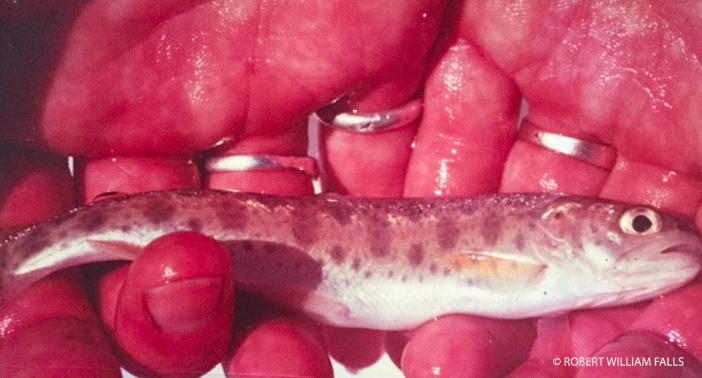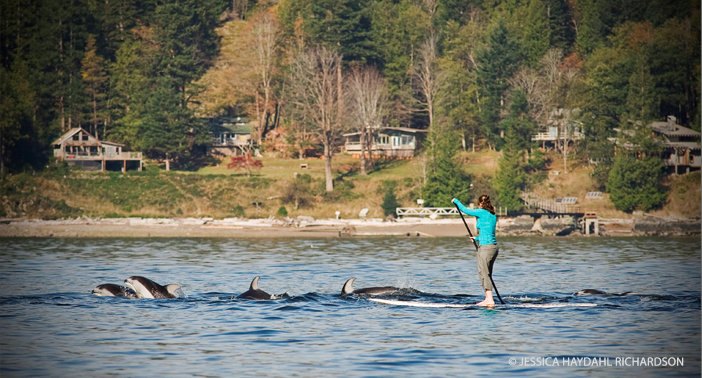JANE GOODALL’S ALL GOOD NEWS: STORIES OF HOPE
On this World Ocean’s Day it must be stated that the overall plight of the oceans is desperately worrying. The oceans, along with the forests of the world, are the two great ecosystems that sequester carbon dioxide. And in so many places we are polluting the oceans to such an extent that they are no longer able to perform this function. They are becoming increasingly polluted from industrial, agricultural and household waste. We are overfishing our oceans and higher water temperatures are causing coral bleaching. And we all know about the vast islands of plastic that can be found far far out in the ocean. Thus on this day when we pay tribute to the oceans and the major role they play in the health of our planet, it is wonderful to be able to share this story of hope, contributed by my friend, Robert Falls.
Dr. Jane Goodall
Guest blog by Robert W. Falls
It was late October 2014, and a light drizzle was falling on the waters of the heavily forested coastline of southwest British Columbia. A boating friend and I had ventured out from our safe moorage at Fisherman’s Cove for a few hours to take in one of the last days of a seemingly endless Indian summer. With the engine silent, and the radio turned off, we slowly drifted less than half a kilometer from the shore of Bowen Island. It was the perfect time to pause and enjoy a warm beverage, and perhaps some contemplation. I indulged in both.
A few kilometers north of here, off Point Finlayson, as a boy of eleven I had spotted my first Bald Eagle from my father’s sixteen foot boat. The massive bird was soaring overhead, its white (not bald) head and white tail feathers illuminated by the sun. I was thrilled — I grabbed my father’s arm and I pointed to the sky. To me, discovering this majestic bird in my own ‘back yard’ was far more valuable than stumbling upon a nugget of gold. A few years later, I was surprised and delighted to discover an Alligator lizard on nearby Keats Island. Apparently lizards were residing on British Columbia’s rain coast! I could hardly believe my eyes. Another surprise, and another treasure — and there would be many more.
As we continued to drift, a creeping chill drove us into the boat’s small cabin. From there, as the wind freshened over the sea, we sipped our tea and peered through the windows in silence. After several moments of gazing over the choppy waters I was startled to see what appeared to be a vertical water column, perhaps 3 meters high. Then it was gone. I said nothing, thinking that my eyes were playing tricks. But there it was again, perhaps 10 meters off our starboard bow — however this time I saw the shadow of a large horizontal body beneath the column of water and mist.
A Childhood Dream Manifest
Then it became obvious – just beneath the ocean’s surface was a large whale, a Pacific Humpback as it turned out. I was astounded. While I had secretly hoped to see whales in Howe Sound since I was a child, it had never happened — until now. I was both flabbergasted and elated.
Howe Sound is a triangularly shaped archipelago, stretching from Bowen Island at its southern extremity, 42 kilometers northeast to the town of Squamish, or Sḵwx̱wú7mesh in the Coast Salish language. The city of Vancouver is 25 kilometers southwest. Howe Sound is but one piece of a complex and much larger network of waterways known as the Salish Sea. Hosting 37 species of mammals, 172 species of birds, and 247 species of fish, the Salish Sea is one of the largest and most biologically rich inland seas on the planet. The combined area of sea and land, which straddles the U.S. Pacific Northwest and Southwest British Columbia, is 20,585 square kilometers, roughly equivalent to the area of Wales. British Columbia’s Desolation Sound defines the northern border of the Salish Sea, while Washington State’s Hammersley Inlet located at the head of Puget Sound marks the southern border.
The whale’s departure was signaled by its huge tail fluke pointed skyward just before the leviathan disappeared on a deep dive, presumably to resume feeding in the dark waters deep beneath us.
My friend and I returned to our moorage at Fisherman’s Cove smiling, and saying very little. We were quietly assimilating what we had experienced.
What was happening?
A few evenings later I shared the story with some boating friends and local musicians at Hugo’s, our community’s unique live music and eclectic food venue. News of our sighting spread quickly, and others began posting their sightings on Youtube. To my surprise, it appeared there was more than one Pacific Humpback Whale occupying Howe Sound. What was happening?
Then it occurred to me. There had been other signs of change in the sea where I grew up.
Earlier that autumn I had spotted from my home, which is perched at the toe of a Howe Sound mountain several kilometers northeast of the whale sighting, a pod of White-Sided Dolphins cavorting and frothing the waters 50 – 100 meters offshore. I watched the spectacle with my binoculars as a nearby paddle boarder was surrounded and graced with a visit. I had to get closer.
After a short drive down-slope and a quick walk to a rocky point lookout, the pod of White-Sided dolphins turned and raced to where I stood – with my jaw hanging. They swished past me at high speed, I am guessing sixty or seventy of them, literally slicing through the water — this was another absolute first-time experience for me, and another dream had come true.
These mammals were known to occur in the Sound, but they certainly were not common, and I had never seen one there despite hundreds of forays in the area. Many times I thought I had seen dolphins in the Sound, but this was always the product of wishful thinking mixed with the illusory wake of a boat unseen. But this sighting? This was the real deal.
More whale encounters continued over the next few months, and these have grown since. As well, the transient Orcas or “Killer” Whales that normally reside off the outer coast of Vancouver Island, are now making 150 km excursions to Howe Sound to dine on Stellar Sea Lions and Harbour Seals on a regular basis.
Some History…
In 1791, when the crew of a Spanish ship became the first Europeans to set their eyes upon this same Sound, and the steep forest-covered islands, fjords and mainland mountains that frame it, the sea was literally teeming with marine life. The Spanish Captain, Francisca de Eliza named it Boca del Carmelo, presumably in reference to the biblical Mt. Carmel in Israel.
One year later a British ship under the command of Captain George Vancouver arrived and an officer offered up the name Howe Sound after Admiral James Howe. This name stuck.
Captains de Eliza and Vancouver would both have encountered the Coast Salish First Nations who had occupied the islands, mainland bays and uplands of this region for thousands of years. These First Nations lived in an abundance of rich seafood, surrounded by waters teeming with migrating runs of salmon and ocean-going trout numbering in the many millions of fish per year.
This extraordinary bounty of salmon, along with herring, cod, rockfish, and many other species of fish and invertebrates, attracted Pacific Humpback, Grey, Minke, Right and Sperm Whales. Orcas, White-Sided Dolphins, Harbor Seals, Harbor Porpoises, Dall’s Porpoises, and Stellar Sea Lions also plied the waterways, while River Otters foraged in the estuaries seeking fish, crustaceans, and amphibians.
Millions of resident and migrating seabirds, including cormorants, scoters, swans, ducks and geese, occupied and foraged the estuaries and shorelines as well. During the salmon spawning season Bald Eagles numbering in the thousands, and representing perhaps the largest congregation in North America, would perch on trees and sandbars along the rivers. On the ocean shores and along the rivers, Grizzly and Black Bears, as well as Timber Wolves, joined in the feast.
An Abundance of Natural Bounty
Supported by the abundance of ocean bounty, robust populations of Blacktail Deer and Roosevelt Elk, and graced by the mild winter climate that characterizes the region, small groups of adventuresome Europeans settled, worked on their homesteads, had families, and began to build their new lives in the area, coexisting in relative harmony with Nature.
The early phase of the area’s settlement was built entirely upon the area’s biological bounty. Lands rich with furbearing mammals drew trappers, while countless runs of migrating salmon headed to nearby spawning rivers drew fisherman, and the region’s unique endowment of forests attracted loggers from around the world. The regenerative capacity of the ecosystems had not been exceeded, and the Europeans and First Nations lived side by side sharing the natural resources of their new and traditional homes.
Harmony and Balance be Gone
However this balance was to be disrupted. It began with the discovery of gold in the Squamish River and areas to the north, which attracted throngs of fortune-seekers from afar. The impacts of the gold discovery and the influx of newcomers it catalyzed were transitory in this region, however the discovery and exploitation of other minerals in the nearby mountains that framed the Sound would disrupt the ecology of the area for a very long time, perhaps forever.
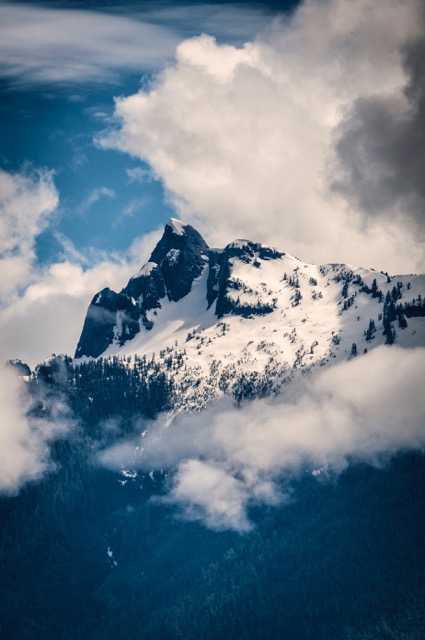
Lions Peak of the mineral-rich Coast Mountain Range bordering Howe Sound. Photo Credit: Jessica Haydahl Richardson
This second wave of disruption was triggered in 1890 with the discovery of an enormous body of copper ore by a medical doctor and a fisherman who were deer hunting on Britannia Mountain, located at the northeast extremity of the Salish Sea.
In just over a decade, the Britannia Mine was built and operating. It would become the largest copper mine in the British Empire. Over 60,000 people lived in the mining community over the 70 year life of the mine, during which 50 million tons of ore were extracted. If a train was assembled to accommodate this production, it would stretch 4000 kilometers across North America from Vancouver to Quebec City. At its peak of operation in 1929, the mine represented 17% of the world’s production of copper.
The Britannia Mine permanently ceased operations in 1974 when economically viable ore reserves ran out. However rainwater and snowmelt continued to run through waste rock in the mine’s tunnels creating a condition known as ‘acid rock drainage’, which was dissolving over a tonne of dissolved copper, iron, cadmium and zinc every two days. The discharge of this acidified, metal-laden water into Britannia Creek, and then Howe Sound, continued unabated for over another three decades.
Visible to those who chose to look beneath the surface of Britannia Creek and the small estuary where it entered the ocean, was a virtual “dead zone”. In the early 1970s government biologists began to assess the area and found that impacts stretched north to the Squamish Estuary, affecting millions of juvenile Chum salmon. Another study revealed that Chinook salmon held in cages at the mouth of Britannia Creek, died in less than 48 hours. Yet another survey confirmed that oysters on Gambier Island located to the south were highly contaminated with zinc and copper. In 2001, Britannia Creek was designated as British Columbia’s most endangered river by the Outdoor Recreation Council.
The Britannia Mine was not the only industrial operation impacting the Sound. Located directly across the north arm of Howe Sound was the Woodfibre pulp and paper plant. The plant was built in 1912 on a site known as “Swig’a’t” by the Coast Salish. Operations discharged countless millions of gallons of effluent laden with toxic chemicals into the Sound for well over half a century. Not surprisingly, biological testing demonstrated highly elevated levels of dioxins and furans, normally associated with pulp mills, in the area’s shellfish. In later years, new effluent treatment systems were installed that if not perfect, were vastly improved. Woodfibre stopped discharging into the Sound when it closed in 2006 as a consequence of the ever-changing economics in the forest products industry.
Sustained Efforts and Natural Forces Team Up
The entire range of the effects of these industrial activities on marine life in the Sound can only be guessed at, but were significant – the question was, were the impacts reversible? Following a sustained public awareness campaign led by the internationally renowned International Rivers Day advocate Mark Angelo during the 1980’s and 1990’s, good intentions started to become reality. The toxic flow from the Britannia Mine site was finally addressed in 2006 after the provincial government and industry joined forces to finance the construction and operation of a highly effective treatment system that would be treating 4.2 billion liters of contaminated runoff per year, removing 226,000 kilograms of heavy metal contaminants. With a capital cost approaching $60 million and an operating cost of $1 million per year, the treatment system will operate for many decades, perhaps centuries to come.
In concert with this treatment facility, halfway up the mountain University of British Columbia engineers and a Squamish company designed and installed a concrete plug in order to contain the pollution from an upstream tributary of Britannia Creek.
The collective benefits of the treatment facility and the concrete plug, which brought the site into compliance under the British Columbia’s Contaminated Sites Regulations, were undeniable and virtually immediate. Over thirty years after the mine closed, the heavy metal pollution of the Sound had been reduced by 99%. Local residents reported that marine life began to return to the once ‘dead zone’ almost immediately.
The full impacts and effects of Britannia, Woodfibre, and other industrial activities in or near the Sound on marine mammals, fish, other marine life, will never be completely known as there was no baseline to compare against.
However, and specifically relating to whales, it is possible that the near disappearance of these large mammals from Howe Sound in the last century was largely the result of commercial whaling operations. During the period of commercial whaling, Pacific Humpback Whale populations on the British Columbia coast plummeted from approximately 20,000 to 1,400, when a whaling moratorium was finally enacted in 1967. The current population estimate is 5,500 whales. Several other whale species were hunted before the moratorium. The last Right Whale to be seen on the coast was harpooned and killed in 1951 by whalers operating out of Vancouver, and seeking other prey.
Thankfully the timeless gift of Nature – including the area’s glaciers, rain forests, and rivers, would eventually restore the water quality of Howe Sound. In concert with Nature, the sustained advocacy efforts, the enforcement of effective environmental protection regulations, and the financing and construction of an effective water treatment system at the Britannia mine site, were all essential to get the job done.
The Tide Turns
After 100 years of unintentional assault, the tide is clearly turning for the marine ecology of the Salish Sea’s spectacular Howe Sound. Experiences similar to ours, with sightings of Pacific Humpback Whales, White-Sided Dolphins, and increasingly frequent Orca visitations, are being enjoyed by a growing number of residents and visitors from around the world.
As I write in June of 2016, juvenile Pacific Humpback Whales are reported to be breaching close to the shore in Vancouver’s English Bay – a stone’s throw from some of the most dense human populations in North America.
I am confident that as our understandings of ecosystem structure and function develop over the next decades, and as pollution abatement technologies and environmental regulations become increasingly effective through the application of sound science and innovation, this story of ecological healing in the Salish Sea will gather momentum.
It is my further hope that the positive outcomes of this sustained and cooperative effort amongst communities, and across disciplines and interests, will inspire a growing number of ecological recovery stories from around the globe.
In the next segment, we will become party to the discovery and exploration of a magnificent ecological treasure of staggering dimensions – hidden deep on the ocean floors of the Salish Sea – and the recently launched innovation that will help explore it.



